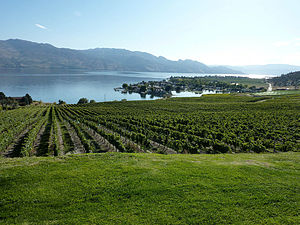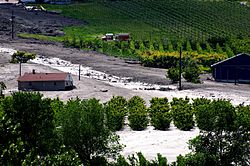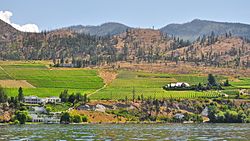- Okanagan Valley (wine region)
-
The Okanagan Valley is a Canadian wine region located in the British Columbia region of the Okanagan. Along with the nearby Similkameen Valley, the approximately 4000 hectares (10,000 acres) of vineyards planted in the Okanagan account for more than 90% of all wine produced in British Columbia and after the Niagara Peninsula of Ontario is Canada's second leading wine producer. Vineyards can be found all along the 113 km (70 mi) Lake Okanagan and many of its neighbouring lakes, including Osoyoos Lake, Skaha Lake and Vaseux Lake. The Okanagan has diverse terrain that features many different microclimates and vineyard soil types.[1][2]
The history of wine production in the Okanagan dates back to the 1850s with the establishment of Okanagan Mission and the planting of grapevines to supply sacramental wines. In the early 20th century, prohibition in Canada wiped out many of the Okanagan's earliest wineries and the commercial wine industry in the area was not revived until the 1930s. From this time, till the mid-1970s, the Okanagan wine industry was based entirely on the production of fruit wines and those produced from hybrid grapes.[3] The first commercial plantings of vinifera came in 1975 when the Osoyoos Indian Band established Inkameep Vineyards (today Nk'mip Cellars).[1]
Contents
History
The first vineyard planted in the Okanagan was at the Oblate Mission in Kelowna in 1859, planted by French Catholic priest Charles Pandosy and was solely intended for the production of sacramental wine for the celebration of the Eucharist. Several small vineyards, planted mostly with Vitis labrusca sprang up until prohibition encouraged the uprooting and replanting with other agricultural crops.[1] For most of the 20th century after prohibition, what limited wine production that took place in the Okanagan was mostly fruit wines made from berries, apples, cherries or even table grapes. One winery, Calona Wines founded in 1932, still remains from that period and is the oldest continuously running winery in British Columbia.[3] Eventually the use of French-American hybrid grapes, such as Marechal Foch and Vidal Blanc took hold, led by the Stewarts of Quails' Gate Estate Winery.[4]
In the mid-1970s, several growers began experimenting with plantings of Vitis vinifera. The Osoyoos Indian band established the first commercial vineyard dedicated to vinifera varieties with plantings of Riesling, Ehrenfelser and Scheurebe.[1] In 1976, notable German viticulturalist and grape breeder Helmut Becker visited the Okanagan and encouraged more growers to consider planting German grape varieties and provided clones of Pinot Blanc, Pinot Gris and Gewürtztraminer that were developed at the Geisenheim Grape Breeding Institute and bred to withstand the cold, winter temperatures of the Okanagan. Further impetus for the planting of vinifera came in the late 1980s when Canada entered into the North American Free Trade Agreement that opened up the Canadian markets to American wines from California, Oregon and Washington. The competition from imported wines spurred the Canadian government to implement a vine pulling scheme with grants for growers who uprooted their hybrid and labrusca vines and replaced them with vinifera.[4]
2010 Mudslides
In June 2010, several vineyards in the southern Okanagan near Oliver were devastated by a dam failure that released 20,000 cubic meters of water, triggering a mudslide with a 180 metre wide swath of debris that extended over kilometres of vineyards and shut down the major roadway through the area. More than 16 hectares of vineyards were damaged by over 240,000 cubic metres of mud and rock.[5]
Geography and climate
The region is located 160 kilometres north from the US border with Washington state and 400 kilometres east of Vancouver between the 49th and 50th parallel north, putting it in the same latitude with the European wine regions of Champagne and Rheingau.[1][2]
While not, officially, yet divided into sub-appellations, the British Columbia Wine Institute list five sub-regions of the Okanagan-Kelowna, Naramata, Okanagan Falls, Golden Mile and Black Sage/Osoyoos.[6]
The Okanagan has a continental climate that is moderated by the deep Lake Okanagan. The Cascade and Coast Mountains create a rain shadow effect shared by adjoining areas of Eastern Washington. This leaves the Okanagan with low annual precipitation totals that range from 150 millimetres in the southern tip of the region around Osoyoos to 300 millimetres in the northern part of the region between Kelowna and Vernon. This means most vineyards require irrigation from nearby water sources [1] Like many wine regions with continental climates, the Okanagan experiences cold winters, with temperatures that can fall as low as -25°C, and bring the risk of frost damage to the vines. However, the last winter to cause severe frost damage in the vines was 1978.[6]
The average temperatures during the growing season months of July and August can be very warm with daytime temperatures reaching 40°C and often staying above 30°C for several days. The region's northerly latitude allows the vines to experience longer hours of daylight than the more southerly vineyards of California receive with late June seeing daybreak around 5 am and sunlight still present as late as 10:30 pm.[6]
Grape varieties and wine styles
Nearly every style of wine is produced across the whole spectrum of sweetness levels that include still, sparkling, fortified and dessert wines--most notably ice wines. There are more than 60 grape varieties grown in the Okanagan including Merlot, Cabernet Sauvignon, Pinot noir, Pinot gris, Chardonnay, Auxerrois[disambiguation needed
 ], Marechal Foch and Cabernet Franc.[1] Additionally many German varieties are still found throughout the Okanagan including Riesling, Gewürztraminer, Bacchus, Optima, Ehrenfelser, Kerner, Seigfried Rebe.[2] In the 21st century, growers have been planting more warm climate varieties typically not associated with the Canadian wine industry. Recent plantings include Sangiovese, Syrah, Tempranillo, Pinotage, Malbec, Barbera and Zinfandel.[7]
], Marechal Foch and Cabernet Franc.[1] Additionally many German varieties are still found throughout the Okanagan including Riesling, Gewürztraminer, Bacchus, Optima, Ehrenfelser, Kerner, Seigfried Rebe.[2] In the 21st century, growers have been planting more warm climate varieties typically not associated with the Canadian wine industry. Recent plantings include Sangiovese, Syrah, Tempranillo, Pinotage, Malbec, Barbera and Zinfandel.[7]References
- ^ a b c d e f g J. Robinson (ed) "The Oxford Companion to Wine" Third Edition pg 133 Oxford University Press 2006 ISBN 0198609906
- ^ a b c The Canadian Encyclopedia ''Wine Industry". Accessed: January 5th, 2011
- ^ a b J. Gordon (ed) Opus Vino pg 126-130, DK Publishing New York 2010, ISBN 756667511
- ^ a b L. Alley ‘’”Canada Finds its Napa”’’ Wine Spectator. August 17th, 2004
- ^ R. Scalza "Mudslide Buries Okanagan Vineyards" Wine Spectator. June 18th, 2010
- ^ a b c British Columbia Wine Institute "BC Wine Basics: The Okanagan Valley" Accessed: January 3rd, 2010
- ^ P. Mitham "B.C. Growers Explore New Grape Varieties" Wines and Vines. January 2008. Accessed: January 3rd, 2011
Categories:- Wine regions of British Columbia
- Okanagan Country
Wikimedia Foundation. 2010.



